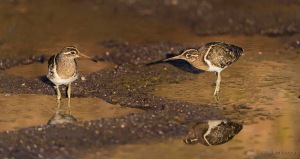Archive for August 16th, 2014
Willem’s Weekly Bird Photography Blog: Week #14
Posted by whk139 in Willem's Weekly Bird Photography blog on August 16, 2014
Week #14: Greater Painted-snipe
I’ve just returned from a photography safari to Mashatu game reserve in the Northern Tule Block in Botswana with Albie Venter and C4 Images & Safaris. And another lifer for me – a Greater Painted-snipe (Goudsnip) (Rostratula benghalensis). Not sure how common the bird in South Africa is, but I did enjoy the sighting tremendously.
Greater Painted-snipe
Nikon D4 camera, Nikkor 600mmf4 lens, f4, ISO 640, 1/5000 sec, exposure = -0.67, 11.9 meters from subject
Possibly male bird with sub-adult chick as chicks tend to stay with male for almost 12 months
____________________________________
Interesting facts:
Medium-sized, plump wading bird. Long reddish-brown bill, slightly decurved at tip, and distinct white or pinkish eye patch. Rounded, buff-spotted wings and short tail. White of breast extends up around top of folded wing. The painted-snipe is not related to the true snipes and differs from them in habits, flight and appearance, being far more colorful and having longer legs than the snipes.
Usually found close to the fringes of reed beds along shorelines of marshes, swamps, ponds and streams. Solitary or in pairs, sometimes in groups of up to 12. Rather shy and retiring, skulking close to the vegetation so that it can retreat to cover if disturbed. When flushed, flies like a rail with legs dangling. Bobs hindquarters on landing and sometimes when walking. Probes for food in the mud.
The female initiates courtship and may mate with more than one male. The nest is usually a shallow scrape in soft ground, lined with plant material and situated among grass or reeds at the water’s edge; sometimes a pad of vegetation or a nest of grass and weeds. The breeding season is between April and July. The male incubates the eggs. Immature birds resemble the male but lack the broken dark band across the breast. Males are also known to carry the chicks to safety under the wings. (Wikipedia)
The chicks leave the nest about 12 hours after they hatch, sticking close to the male, who provides them with food for at least the first 10 days (at which point they start to forage for themselves). The male may also perform distraction displays if a predator approaches. They fledge at about 30-35 days old, remaining with the male for another 1-2 months. (http://www.biodiversityexplorer.org/birds/rostratulidae/rostratula_benghalensis.htm)
Map – distribution:
http://www.biodiversityexplorer.org/birds/rostratulidae/rostratula_benghalensis.htm
Until next time – keep on shooting

